A chilly morning gradually changed over to a delightfully mild late morning, and we had a great walk going upstream from Hudson Gardens, even included a brief detour up Lee Gulch where an American Dipper had been recently reported. We whiffed on the Dipper, but did get great views of a number of other birds.
For starters, we had a nice mix of Cackling Geese and Canada Geese out on the South Platte. Generally speaking, there are four main characteristics that can be used in differentiating these very similar “white-cheeked” geese. However, complications arise because there are roughly six subspecies of Cackling Goose and eleven subspecies of Canada Goose, all of which vary slightly in size, coloration, and shape. The first, and perhaps most import characteristic, is the bill size, its shape, and its length, as compared to the width of the side of the head. Compared to Canada Geese the bills of Cackling Geese are shorter, closer to being an equilateral triangular shape, and their length is about 50% (or less) of the width of the side of the head. Overall, Cacklers are smaller (3.1 – 6.6 lbs), while Canada Geese are bigger (5.7 14.3 lbs). Cacklers tend to have shorter, thicker necks. And, finally, there are some subtle differences in plumages, e.g. some Cackler subspecies have darker breasts, some have a white neck-ring, and some have a grayish sheen on their back. On Saturday we got good looks at both species, and started to work towards getting a little more tuned in to all these differences.
Another waterbird of interest that we saw was a Pied-billed Grebe. “Pied” means having two or more different colors, and the name derives from their bill, during breeding season, being white with a distinct black band. Grebes are not ducks, as they have lobed toes, not webbed feet, to assist them in diving. However, for the most part they don’t have to dive to go under water; they can simply adjust their buoyancy such that they can float with differing amounts of their body above the water, or they can simply slowly submerge themselves with hardly a ripple.
We also had six species of ducks on the river, and we got to really delve into their identification – working on telling the males from the females, and what the main plumage characteristics were. One of these challenges had to do with telling first-year male Buffleheads from adult females (get out your field guides). In looking at the photo notice how much bigger the adult male is. Males tend to be about 1-3″ longer than the females, and weigh about 4 ounces more, so I’m saying that what we saw were females, but I am not confident in doing so.
The highlight of the ducks was getting to see a small flock of twelve Greater Scaup fly in and land right in front of us on the river. This is a rare to uncommon species on the eastern plains near the foothills, and we were quite fortunate to get excellent looks. On the males we were able to note their bright white flanks, thick neck, head sloping towards the rear and long from bill to nape and smoothly rounded (no hint of the peaky head that characterizes the Lesser Scaup – a far more common winter duck), broad black nail on the tip of bill, eye not centered in head – but higher and more forward, BIG jowls, and some green noted in the head coloring. On the females we noted the extensive white behind bills. Also, fortunately, one of our participants, Nona Radin, took some great photos.
Finally, some of us got good looks at a single Ruby-crowned Kinglet traveling with a little flock of Black-capped Chickadees. This diminutive bird with its tiny bill is a common summer resident up in the mountains, but it is a rare to uncommon winter resident on the eastern plains near the foothills.
So, though we only recorded 23 species, we got great looks at some really special birds – not to mention three muskrats. Hope you can join us on a future Hudson Gardens bird walk, or check out the walks being offered on the first Saturday of each month by the Front Range Birding Company – call 303-979-2473 for more info and to sign up for a walk.
Good birding,
Chuck
Hudson Gardens, Jan 25, 2020
23 species
Cackling Goose 80
Canada Goose 300
Gadwall 11
Mallard 35
Green-winged Teal 9
Greater Scaup 12
Bufflehead 13
Common Goldeneye 6
Pied-billed Grebe 1
Killdeer 1
Ring-billed Gull 1
Great Blue Heron 1
Belted Kingfisher 1
Northern Flicker 7
Blue Jay 1
Black-billed Magpie 3
American Crow 4
Black-capped Chickadee 8
Ruby-crowned Kinglet 1
Red-breasted Nuthatch 2
House Finch 14
Dark-eyed Junco (Oregon) 1
Red-winged Blackbird 4


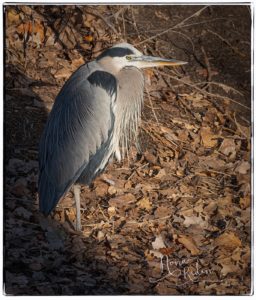
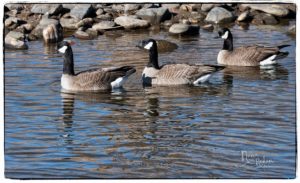
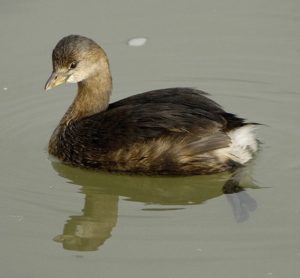
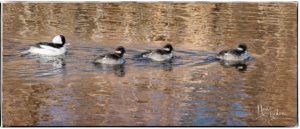
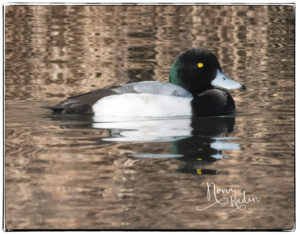
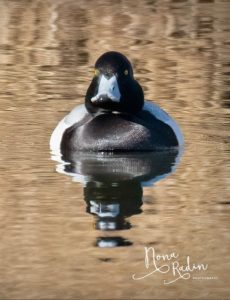
Comments
Write Comment